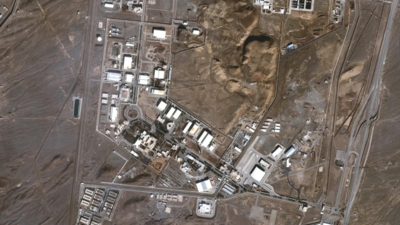
US President Donald Trump announced Saturday evening that the United States has launched precision airstrikes on three of Iran’s most critical nuclear facilities -- Fordow, Natanz, and Isfahan."All planes are now outside of Iran air space," Trump posted on Truth Social. "A full payload of BOMBS was dropped on the primary site, Fordow. There is not another military in the World that could have done this. NOW IS THE TIME FOR PEACE!"
What we know about the targeted sites:
Natanz
The Natanz facility, located around 220 kilometers southeast of Tehran, is the center of Iran’s uranium enrichment efforts. It had already been struck by Israeli airstrikes before the latest round of attacks.
According to the UN’s nuclear watchdog, uranium at Natanz had been enriched to 60% purity -- a level close to weapons-grade. Israel destroyed the above-ground parts of the facility, and further damage was reported underground where powerful centrifuges were located. The International Atomic Energy Agency (IAEA) believes most of these machines were taken out when the power supply was cut during the attack.The IAEA confirmed that any radioactive contamination stayed within the site and didn’t spread to nearby areas.
Iran had also begun building new sections deeper underground, near a nearby mountain called Kūh-e Kolang Gaz Lā (Pickax Mountain), to better shield its operations. Over the years, Natanz has faced multiple attacks, including the infamous Stuxnet virus — a cyberweapon believed to have been created by the US and Israel -- and other airstrikes linked to Israel.
Fordow
Fordow, another enrichment facility, is about 100 kilometers southwest of Tehran.
While not as large as Natanz, it is considered much harder to strike because it’s built under a mountain and protected by anti-aircraft systems. Iran kept the site secret until 2009, when Western intelligence discovered it and exposed its existence. It houses advanced centrifuges that work together to enrich uranium.Because it is buried so deeply, only highly specialized bombs, like the US-made GBU-57 "bunker buster," can potentially destroy it.
These bombs are massive -- weighing around 30,000 pounds -- and can only be dropped by America’s B-2 Spirit stealth bombers, operated solely by the US Air Force. This means any serious attack on Fordow would likely require direct US involvement.
Isfahan
The Isfahan Nuclear Technology Center lies about 350 kilometers southeast of Tehran and is known for being Iran’s major nuclear research hub. It employs thousands of scientists and contains three research reactors supplied by China.
Alongside the reactors, the site also includes laboratories and a uranium conversion facility, which plays a key role in the early stages of nuclear fuel production.Israel has carried out strikes on parts of the Isfahan site, including the conversion plant. However, the IAEA has confirmed that there has been no increase in radiation levels after the strikes, indicating that the attacks did not cause nuclear leakage.
Other sites not struck
While Natanz, Fordow, and Isfahan were hit, several other parts of Iran’s nuclear program have not been targeted by recent airstrikes. The most notable is the Bushehr nuclear power plant, located along the Persian Gulf, around 750 kilometers south of Tehran. This facility is used for civilian energy and is fueled by uranium from Russia. It remains under IAEA supervision.Another important site is the Arak heavy water reactor, situated southwest of Tehran.
Although it has the potential to produce plutonium -- a material used in nuclear weapons -- Iran had agreed to redesign it under the 2015 nuclear deal to reduce international concerns. Lastly, the Tehran Research Reactor, housed within the Atomic Energy Organization of Iran’s headquarters, once required highly enriched uranium.
It has since been modified to use low-enriched uranium as a non-proliferation measure.
Background to the escalation
The US airstrikes follow closely on the heels of Israel’s own offensive, dubbed Operation Rising Lion, aimed at disrupting Iran’s nuclear program. Iran responded with retaliatory actions of its own earlier this week.
Iran's nuclear history
Iran’s nuclear journey began in 1957 with assistance from the US under the Shah’s regime, focused on peaceful energy development. After the 1979 Islamic Revolution, relations soured and American support ended. Despite being a signatory to the UN’s Nuclear Non-Proliferation Treaty (NPT) -- which prohibits the development of nuclear weapons -- Iran’s intentions have long been a subject of global suspicion.Now, with strikes on its nuclear heartland, the region stands at a dangerous crossroads -- with the possibility of diplomacy or a wider war hanging in the balance.

 4 hours ago
40
4 hours ago
40




























 English (US)
English (US)